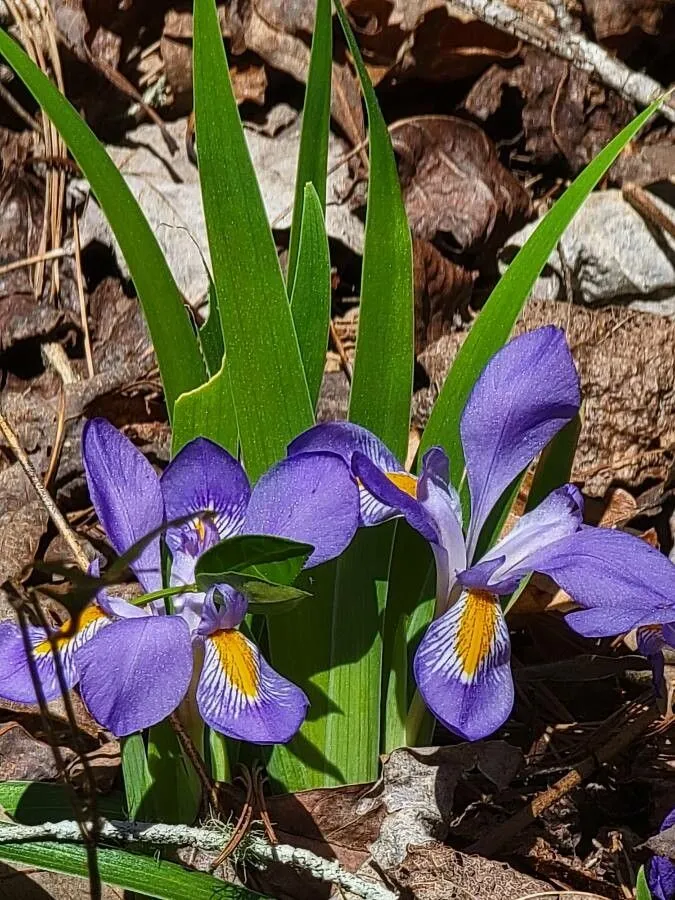
Author: L.
Bibliography: Sp. Pl.: 39 (1753)
Year: 1753
Status: accepted
Rank: species
Genus: Iris
Vegetable: Unknown
Observations: E. U.S.A.
The Dwarf Iris, scientifically known as Iris verna, is a captivating and delicate member of the Iridaceae family. This perennial plant, first documented by the renowned botanist Carl Linnaeus in his seminal work Species Plantarum in 1753, flourishes predominantly in the eastern regions of the United States.
This miniature beauty brings a touch of elegance to gardens and wild landscapes with its vibrant blooms. The flowers, often displaying a rich palette of blue to violet hues, emerge in the spring and are characterized by their distinct, intricate petal formations. Each blossom elegantly stands atop a slender stem, which typically grows to a modest height, befitting the plant’s common name ‘Dwarf’ Iris.
Iris verna thrives in well-drained soils and prefers a sunny to partially shaded environment. It is particularly accustomed to the temperate climate typical of the eastern U.S., adapting well to the region’s seasonal variations. Known for its hardiness and low-maintenance nature, this iris makes an excellent addition to rock gardens, woodland gardens, and border fronts, where its compact growth and striking flowers can be appreciated up close.
The Dwarf Iris is not just a visual delight but also an important part of the local ecosystem. It attracts a variety of pollinators, including bees and butterflies, thus playing a crucial role in the propagation of its species and the health of its habitat.
In addition to its ecological contributions, Iris verna has been utilized in traditional practices and modern horticulture. Its rhizomes are notable for their applications, though it is paramount to handle them with care, as parts of the plant can be toxic if ingested.
In summary, the Dwarf Iris (Iris verna) is a testament to the beauty and resilience of native flora in the eastern United States. With its historical botanical significance, ecological value, and aesthetic appeal, this exquisite plant continues to enchant botanists, gardeners, and nature enthusiasts alike.
Eng: dwarf iris, dwarf violet iris, slender blue flag, violet iris
En: Dwarf iris, Dwarf violet iris, Violet iris, Slender blue flag
Fa: زنبق بنفش کوتوله
Taken Apr 3, 2020 by Nate Wajler (cc-by-sa)
Taken Apr 1, 2018 by Anja Collette (cc-by-sa)
Taken Apr 9, 2021 by jennifer lowry (cc-by-sa)
Taken May 14, 2020 by Pam Herbert (cc-by-sa)
Taken Apr 1, 2022 by Stephen Tracy (cc-by-sa)
Taken Apr 25, 2013 by EOL − Suzanne Cadwell (cc-by-nc)
Taken Jun 6, 2013 by EOL − Johnny Wilson (cc-by-nc)
Taken Jan 1, 1900 by EOL − WVU Herbarium (cc-by-nc-sa)
Taken Jan 1, 1900 by EOL − WVU Herbarium (cc-by-nc-sa)
Taken Jan 1, 1900 by EOL − WVU Herbarium (cc-by-nc-sa)
Family: Myrtaceae Author: (F.Muell.) K.D.Hill & L.A.S.Johnson Bibliography: Telopea 6: 402 (1995) Year: 1995 Status:…
Family: Rubiaceae Author: Pierre ex A.Froehner Bibliography: Notizbl. Bot. Gart. Berlin-Dahlem 1: 237 (1897) Year:…
Family: Sapindaceae Author: Koidz. Bibliography: J. Coll. Sci. Imp. Univ. Tokyo 32(1): 38 (1911) Year:…
Family: Asteraceae Author: A.Gray Bibliography: Pacif. Railr. Rep.: 107 (1857) Year: 1857 Status: accepted Rank:…
Family: Fabaceae Author: Medik. Bibliography: Vorles. Churpfälz. Phys.-Ökon. Ges. 2: 398 (1787) Year: 1787 Status:…
Family: Aspleniaceae Author: (Cav.) Alston Bibliography: Bull. Misc. Inform. Kew 1932: 309 (1932) Year: 1932…